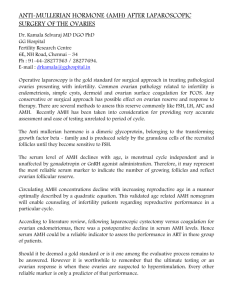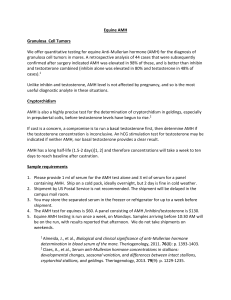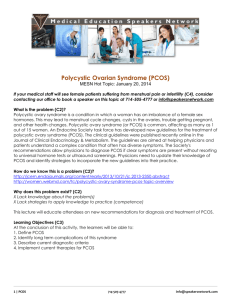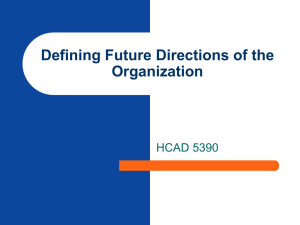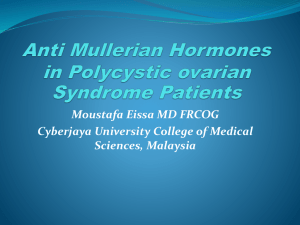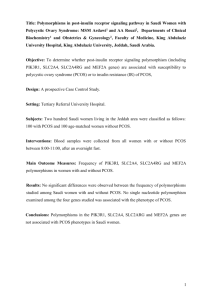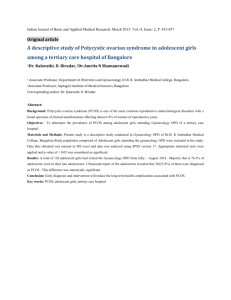Serum Anti-Müllerian Hormone Concentrations Are Elevated in
advertisement
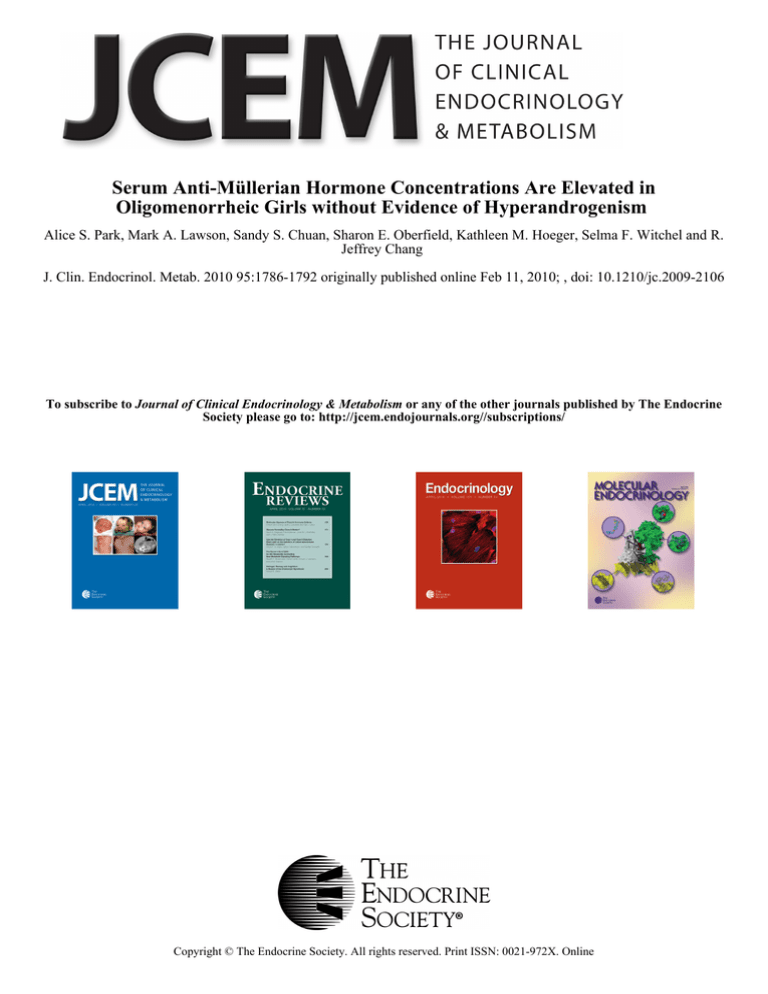
Serum Anti-Müllerian Hormone Concentrations Are Elevated in Oligomenorrheic Girls without Evidence of Hyperandrogenism Alice S. Park, Mark A. Lawson, Sandy S. Chuan, Sharon E. Oberfield, Kathleen M. Hoeger, Selma F. Witchel and R. Jeffrey Chang J. Clin. Endocrinol. Metab. 2010 95:1786-1792 originally published online Feb 11, 2010; , doi: 10.1210/jc.2009-2106 To subscribe to Journal of Clinical Endocrinology & Metabolism or any of the other journals published by The Endocrine Society please go to: http://jcem.endojournals.org//subscriptions/ Copyright © The Endocrine Society. All rights reserved. Print ISSN: 0021-972X. Online ORIGINAL E n d o c r i n e ARTICLE C a r e Serum Anti-Müllerian Hormone Concentrations Are Elevated in Oligomenorrheic Girls without Evidence of Hyperandrogenism Alice S. Park, Mark A. Lawson, Sandy S. Chuan, Sharon E. Oberfield, Kathleen M. Hoeger, Selma F. Witchel, and R. Jeffrey Chang Department of Reproductive Medicine (A.S.P., M.A.L., S.S.C., R.J.C.), University of California, San Diego, La Jolla, California 92093; Department of Pediatrics (S.E.O.), Columbia University Medical Center, New York, New York 10032; Department of Obstetrics and Gynecology (K.M.H.), University of Rochester Medical Center, Rochester, New York 14642; and Department of Pediatrics (S.F.W.), University of Pittsburgh Medical Center, Pittsburgh, Pennsylvania 15213 Context: Serum anti-Müllerian hormone (AMH) levels are significantly elevated in adolescents with polycystic ovary syndrome (PCOS) compared to normal controls. Whether adolescents with oligomenorrhea have elevated AMH levels is unknown. Objective: This study was performed to assess serum AMH levels in oligomenorrheic (OLIGO) girls without evidence of hyperandrogenism. Design: This was a prospective study comparing AMH levels in OLIGO, PCOS, and normal control adolescents. Setting: The study was conducted through four tertiary academic medical centers. Participants: The study groups were comprised of OLIGO (n ⫽ 24), PCOS (n ⫽ 153), and normal adolescent girls (n ⫽ 39), as well as PCOS (n ⫽ 73) and normal adult women (n ⫽ 36). Interventions: In each subject, serum AMH levels were assessed in the early to midfollicular phases for regularly menstruating subjects and on an arbitrary day for OLIGO or PCOS subjects. Main Outcome Measure(s): Basal serum AMH levels were assessed among OLIGO, PCOS, and normal girls, in addition to PCOS and normal women. Results: OLIGO girls had serum AMH levels (5.33 ⫾ 0.47 ng/ml) that were significantly greater than the normal adolescents (3.05 ⫾ 0.31 ng/ml) and adults (2.33 ⫾ 0.22 ng/ml), but similar to values seen in the PCOS adolescents (5.28 ⫾ 0.26 ng/ml) and adults (6.36 ⫾ 0.47 ng/ml). Obese adolescents and PCOS women had significantly lower AMH levels compared to lean controls (P ⬍ 0.02). Conclusion: In OLIGO adolescents, elevated serum AMH levels suggest increased antral follicle number similar to that observed in girls with PCOS. (J Clin Endocrinol Metab 95: 1786 –1792, 2010) t has been well recognized that the onset of polycystic ovary syndrome (PCOS) occurs at or soon after puberty, coincident with increasing ovarian follicular activity and steroidogenesis. Typically, characteristic features are irregular menstrual bleeding, evidence of hyperandrogenism, and polycystic ovaries. The diagnosis may be de- I termined by the presence of any two of these features (1). In young adolescent girls, symptoms of PCOS emerge insidiously and are often indistinguishable from those that accompany normal pubertal development. Detection of PCOS in adolescent girls may be predicated on hyperandrogenic symptoms such as hirsutism and acne. Irregular ISSN Print 0021-972X ISSN Online 1945-7197 Printed in U.S.A. Copyright © 2010 by The Endocrine Society doi: 10.1210/jc.2009-2106 Received October 1, 2009. Accepted January 19, 2010. First Published Online February 11, 2010 Abbreviations: A, Androstenedione; AMH, anti-Müllerian hormone; BMI, body mass index; CV, coefficient of variation; E2, estradiol; FAI, free androgen index; NC, normal control; 17-OHP, 17-hydroxyprogesterone; OLIGO, oligomenorrheic; PCO, polycystic ovary; PCOS, PCO syndrome. 1786 jcem.endojournals.org J Clin Endocrinol Metab, April 2010, 95(4):1786 –1792 J Clin Endocrinol Metab, April 2010, 95(4):1786 –1792 menstrual bleeding is less reliable because anovulation generally follows menarche and abnormal cycles may persist for several years. Previously, we have shown that oligomenorrheic (OLIGO) adolescent girls without evidence of hyperandrogenism may exhibit increased pulsatile LH secretion similar to girls with PCOS (2). However, whether these OLIGO girls fulfilled the diagnostic criteria for PCOS is unclear because ovarian imaging was not performed. According to Rotterdam criteria, menstrual irregularity together with evidence of polycystic ovaries is consistent with a diagnosis of PCOS. Not infrequently, optimal ovarian imaging by vaginal ultrasonography is not possible in adolescent girls due to virginal status, and abdominal ultrasound is often encumbered by the presence of obesity. Anti-Müllerian hormone (AMH), also known as Müllerian-inhibiting substance, is a growth and differentiation factor that is mainly known to induce regression of the Müllerian ducts during male sex differentiation of the fetus. In women, AMH is produced by ovarian granulosa cells from around 36 wk gestation up until menopause. Recently, it has been demonstrated that serum AMH levels correlate closely with early antral follicle number in normal women and women with PCOS (3). This finding is in agreement with in vitro studies that have found maximal AMH mRNA expression in granulosa cells of growing preantral and small antral follicles (4). Because of the close correlation of circulating AMH to the antral follicle count, it has been suggested that serum AMH may be a suitable biological marker of ovarian follicle number (5), particularly in those individuals with irregular menstrual bleeding or hyperandrogenism. In adolescent girls with PCOS, circulating AMH levels are significantly increased compared with that of normal girls, which is consistent with corresponding values observed in adult PCOS and normal women, respectively (6). A comparison of serum AMH concentrations between adolescent PCOS and girls with irregular menstrual bleeding or oligomenorrhea without evidence of hyperandrogenism has not been reported. Therefore, considering that AMH may reflect antral follicle number, we undertook to assess serum AMH concentrations in adolescent girls with OLIGO, PCOS, and normal menstrual cycles. Subjects and Methods jcem.endojournals.org 1787 rhea was defined as having an average menstrual cycle length between 45 and 90 d, based on a normal menstrual interval of 21– 45 d in young females (7). The diagnosis of PCOS was based on clinical and/or biochemical evidence of hyperandrogenism and irregular menstrual bleeding, according to the 1990 National Institutes of Health Conference on PCOS and consistent with the 2003 Rotterdam PCOS Consensus Workshop. Hyperandrogenism was based on the presence of hirsutism (Ferriman-Gallwey score ⱖ 8) and/or elevated serum testosterone (T). Elevated serum T levels were defined as T values greater than 2 SD of the normal control (NC) population (T ⬎ 0.51 ng/ml). Based on this definition, three of the OLIGO girls were noted to have an elevated T level and were reclassified as having PCOS, giving a total of 24 OLIGO girls and 153 PCOS adolescents. Among the PCOS girls, 146 were hirsute, and 58 had elevated serum T levels. All PCOS subjects had oligomenorrhea or secondary amenorrhea. Among the 43 normal adolescent girls, four were discovered to have elevated T levels and were eliminated from the study, resulting in 39 NCs. None of the NC girls were hirsute. For comparison, an adult population of 73 PCOS women and 36 normal women with regular menstrual cycles were included in the study. For data analysis, the subjects were stratified by body mass index (BMI) into nonobese and obese groups. For adolescents, obesity is defined as a BMI greater than 95% for age and sex based on data from the National Health and Nutrition Examination Survey. The average BMI of an adolescent greater than the 95% is about 25 kg/m2. Therefore, obese adolescents in this study were defined as having a BMI of at least 25 kg/m2 and nonobese subjects as having a BMI below 25 kg/m2. In adults, obesity was defined as having a BMI of at least 30 kg/m2. All subjects were euthyroid, without evidence of hyperprolactinemia or adrenal enzyme defect determined by 17-hydroxyprogesterone (17-OHP) levels at time of serum collection. No subjects were on any medications known to modulate or modify the menstrual cycle. Baseline clinical characteristics of all the subjects are presented in Table 1. Informed consent was obtained from the legal guardian of each subject less than 18 yr of age and from those subjects 18 yr or older before participation in this study. Informed assent was obtained from study subjects less than 18 yr of age. The study was approved by the Institutional Review Board of the University of California, San Diego; Columbia-Presbyterian; Rochester Medical Centers; and the University of Pittsburgh Children’s Hospital. Procedures Baseline serum samples were collected from previous or concurrent adolescent studies conducted at each study site. In OLIGO and PCOS girls, baseline blood samples were drawn on an arbitrary day. Absence of recent ovulation was confirmed in the OLIGO and PCOS subjects by lack of menses 2 wk after study or by serum progesterone levels of less than 1 ng/ml at the baseline sample. All adolescent NC serum samples were obtained from the early to midfollicular phase of the menstrual cycle. In adult women, blood samples were obtained in a similar manner as in the adolescent population, except that all subjects were from the University of California, San Diego. Subjects Twenty-seven nonhirsute girls with oligomenorrhea, 150 adolescent girls with PCOS, and 43 normal adolescent girls with regular menstrual cycles were recruited for study. Oligomenor- Assays Samples were collected, processed, and stored at ⫺20 C until ready for analysis. The samples were analyzed in three separate 1788 Park et al. Serum AMH Levels in Oligomenorrheic Girls J Clin Endocrinol Metab, April 2010, 95(4):1786 –1792 TABLE 1. General characteristics and basal steroid hormone levels in adolescent subjects n Age (yr) BMI (kg/m2) A (ng/ml) T (ng/ml) 17-OHP (ng/ml) E2 (pg/ml) SHBG (g/dl) FAI FSH (mIU/ml) LH (mIU/ml) OLIGO 24 16.4 ⫾ 0.4a (16.0, 13.1–18.2) 30.9 ⫾ 1.5 (32.0, 20.0 – 44.2) 1.2 ⫾ 0.1a,b (1.1, 0.36 –2.2) 0.3 ⫾ 0.03b (0.3, 0.1– 0.5) 1.5 ⫾ 0.2 (1.4, 0.4 – 4.7) 46.6 ⫾ 5.7 (39.2, 21.5–131.6) 0.96 ⫾ 0.13a,b (0.76, 0.30 –2.22) 12.1 ⫾ 7.7b (3.6, 1.7–57.5) 5.4 ⫾ 0.4 (6.0, 1.8 – 8.9) 6.4 ⫾ 1.0a,b (4.7, 1.3–20.2) PCOS 153 15.7 ⫾ 0.1c (15.7, 13.0 –18.1) 34.1 ⫾ 0.6c (34.0, 22.8 – 46.4) 1.7 ⫾ 0.1c (1.6, 0.9 –2.6) 0.5 ⫾ 0.03c (0.5, 0.2–1.0) 1.8 ⫾ 0.1c (1.6, 0.7–3.6) 56.9 ⫾ 3.0 (47.9, 23.4 –128.1) 0.37 ⫾ 0.03 (0.29, 0.05–1.0) 22.0 ⫾ 1.9c (16.0, 3.6 – 66.7) 4.8 ⫾ 0.2 (4.9, 1.3–7.7) 9.3 ⫾ 0.7c (8.6, 1.7–22.4) NC 39 14.6 ⫾ 0.4 (15.0, 12.0 –14.0) 29.9 ⫾ 1.0 (30.1, 20.0 – 40.0) 0.9 ⫾ 0.1 (0.9, 0.3–1.6) 0.2 ⫾ 0.03 (0.2, 0.1– 0.4) 1.3 ⫾ 0.1 (1.2, 0.4 –3.4) 47.4 ⫾ 4.9 (35.7, 19.9 –141.7) 0.50 ⫾ 0.04 (0.51, 0.19 –1.0) 5.1 ⫾ 0.5 (4.4, 1.6 –12.3) 4.8 ⫾ 0.7 (4.4, 1.1–10.3) 2.2 ⫾ 0.4 (1.8, 0.13–5.8) Data are expressed as mean ⫾ SE (median, 5–95%). To convert to SI units for A, multiply by 3.49; for T, by 3.47; for 17-OHP, by 3.03; for E2, by 3.67; and for SHBG, by 40.2. a P ⬍ 0.05 for OLIGO vs. NC. b P ⬍ 0.05 for OLIGO vs. PCOS. c P ⬍ 0.05 for PCOS vs. NC. batches. Each sample was measured in duplicate for androstenedione (A), T, 17-OHP, estradiol (E2), SHBG, LH, FSH, and AMH. Serum A, T, and E2 values were measured by well-established RIA (8) with intraassay coefficient of variation (CV) less than 7%. 17-OHP was measured by RIA with intraassay CV less than 7% (Diagnostic Systems Laboratory, Inc., Webster, TX). SHBG was determined by Diagnostic Systems Laboratory kit 6300, with intraassay and interassay CVs of 2.5 and 3.73%, respectively. The free androgen index (FAI) was calculated according to the following formula: [total T ⫻ 100/SHBG] (9). Serum LH and FSH were measured by RIA, with intra- and interassay CV for LH of 5.4 and 8.0%, respectively, and for FSH of 3.0 and 4.6%, respectively (Diagnostic Products Corp., Los Angeles, CA). Serum AMH levels were assessed using ELISA (Diagnostic Systems Laboratory, Inc.) with intra- and interassay CVs of 4.12 and 6.19%, respectively. Statistical analysis Comparisons between groups on continuous measures were made using paired t tests or repeated-measure one-way ANOVA. When ANOVA reached statistical significance, independent comparisons were made using Tukey-Kramer honestly significant difference. The AMH data were log-transformed for the adolescent group and Box-Cox transformed for the adult group to obtain a normal distribution of the data. Correlation analysis was done using Pearson correlation and fixed model multiple regression. Results are reported as the mean ⫾ SE, and P ⬍ 0.05 was considered significant. NCSS 2007 (NCSS, Kaysville, UT) and JMP version 8 (SAS Institute, Inc., Cary, NC) were used to perform the statistical analysis. Results Baseline clinical and hormone measurements The mean age of OLIGO subjects was similar to that of PCOS girls, and both were greater than that of normal adolescents (Table 1). The mean BMI in OLIGO girls was not different from that of PCOS or normal subjects. By comparison, BMI values in PCOS girls were significantly higher than those of the normal group. In the OLIGO group, serum androgen and LH levels were intermediate between values observed for PCOS and normal girls. Notably, in OLIGO girls, mean A, T, and LH levels were significantly lower compared with adolescent PCOS, whereas serum A and LH were higher compared with normal girls (Table 1). Serum 17-OHP, SHBG, E2, and FAI in OLIGO girls were similar compared with either PCOS or normal adolescents. Not unexpectedly, serum T, 17-OHP, SHBG, and the FAI in PCOS girls were greater than those observed in NCs. Circulating FSH concentrations were not different among groups. Among adult women, PCOS subjects were significantly younger (28.5 ⫾ 0.70 vs. 32.0 ⫾ 1.5 yr) and heavier (35.0 ⫾ 1.2 vs. 27.7 ⫾ 1.7 kg/m2) compared with corresponding values observed in NCs. Women with PCOS also exhibited increased levels of serum LH, T, A, 17-OHP, and FAI, whereas circulating FSH was lower than that of normal adults. There was no difference in serum concentra- J Clin Endocrinol Metab, April 2010, 95(4):1786 –1792 jcem.endojournals.org 1789 TABLE 2. Pairwise t test comparisons between obese and nonobese adolescents and adults Group Adolescents OLIGO PCOS NC Adults PCOS NC FIG. 1. Comparison of serum AMH levels among NC, OLIGO, and PCOS adolescents, and normal and PCOS adults. AMH values in OLIGO and both PCOS groups were similar. In each of these groups, mean serum AMH was greater than that observed in either adolescent or adult NC (P ⬍ 0.001). There was no significant difference between the NC groups. *, Significantly different from NC adolescent (P ⬍ 0.001). tions of E2 and SHBG between the PCOS and normal women (data not shown). Basal serum AMH levels ANOVA with Tukey-Kramer post hoc testing was used to determine significant differences in mean AMH levels between all groups studied. The basal serum AMH levels were similar in OLIGO (5.33 ⫾ 0.47 ng/ml) and PCOS (5.28 ⫾ 0.26 ng/ml) girls and in PCOS adults (6.36 ⫾ 0.47 ng/ml). Similarly, there was no significant difference between the NC adolescents (3.05 ⫾ 0.31 ng/ml) and the NC adults (2.33 ⫾ 0.22 ng/ml). A significant difference was found between the OLIGO, PCOS, and adult PCOS subjects compared with the adolescent and adult NC subjects, P ⬍ 0.001 (Fig. 1). Relationship of serum AMH levels to BMI Pairwise comparison of serum AMH between obese and nonobese subjects revealed that AMH levels were significantly greater in the nonobese compared with the obese subjects within each group of NC (P ⫽ 0.05), OLIGO (P ⫽ 0.01), and PCOS (P ⬍ 0.01) adolescents (Table 2). In the adults, the disparity between lean and obese subjects was maintained in the PCOS group (P ⫽ 0.01). In the NC women, mean AMH levels were greater in the nonobese compared with the obese controls but did not achieve statistical significance. Subsequent Pearson correlation analysis demonstrated a significant inverse correlation between AMH and BMI for the adolescent subjects (P ⫽ 0.002) and the adult subjects with PCOS (P ⫽ 0.002) (data not shown). Serum AMH levels compared with androgens Fixed model multiple regression analysis was used to assess the relationship between serum AMH levels and Nonobese Obese P value 7.12 ⫾ 0.60 8.52 ⫾ 0.97 4.08 ⫾ 0.82 4.60 ⫾ 0.52 4.89 ⫾ 0.30 2.70 ⫾ 0.30 ⬍0.02 ⬍0.01 0.05 8.52 ⫾ 0.97 2.10 ⫾ 0.33 4.89 ⫾ 0.30 1.15 ⫾ 0.28 ⬍0.02 0.11 Values are expressed as mean (⫾SE) serum AMH (ng/ml). To convert to SI units for AMH, multiply by 7.14. ovarian androgens using the model: log (AMH) ⫽ A ⫹ T ⫹ 17-OHP ⫹ FAI for the adolescents, and the equation (AMH ˆ 0.4 ⫺ 1)/0.18813297019488 ⫽ A ⫹ T ⫹ 17OHP ⫹ FAI for the adults. Serum AMH in both the adolescents and adults showed a significant positive association with A only. In addition, A had the strongest association with AMH, determined by the coefficient of determination, R2, in both the adolescents and adults (Table 3). BMI is a significant variable in the fixed model analysis, but the overall conclusions regarding the relationship between serum AMH levels and ovarian androgens was the same whether or not BMI was included in the model. Discussion The results of this study have revealed that adolescent girls with oligomenorrhea and no clinical or biochemical evidence of hyperandrogenism exhibit significantly elevated serum AMH levels compared with values observed in normal girls with regular menstrual cycles. By comparison, TABLE 3. Results of fixed-model multiple regression analysis using androgens (A, T, 17-OHP, and FAI) as the independent variable and AMH as the dependent variable Model Adolescents A T 17-OHP FAI Adults A T 17-OHP FAI b(i) SE P value 0.069 0.058 ⫺0.026 0.001 0.014 0.033 0.025 0.001 ⬍0.001 0.078 0.309 0.305 0.643 0.679 ⫺0.331 0.005 0.195 0.555 0.297 0.029 0.002 0.226 0.270 0.855 R2 0.291 (model R2) 0.113 0.015 0.005 0.005 0.419 (model R2) 0.097 0.013 0.011 0.001 Model: Log AMH ⫽ A ⫹ T ⫹ 17-OHP ⫹ FAI for the adolescents, and (AMH ˆ 0.4 ⫺ 1)/0.18813297019488 ⫽ A ⫹ T ⫹ 17-OHP ⫹ FAI for the adults. b(i), Regression coefficient; R2, whole model adjusted R2 and individual R2 as noted. 1790 Park et al. Serum AMH Levels in Oligomenorrheic Girls circulating AMH values are essentially indistinguishable between OLIGO and PCOS adolescents. Relative to adults, mean AMH levels in OLIGO and PCOS girls were similar to those of PCOS women and significantly higher than those of normal women. Serum AMH levels tended to be higher in normal adolescent girls compared with normal adult women. There is an absence of available data regarding serum AMH levels in adolescent girls with oligomenorrhea, and there are relatively few published reports of circulating AMH in adolescence. In normal girls, studied from infancy to adulthood, assessment of AMH levels revealed a gradual rise from 1–2 yr of age that achieved peak levels at ages 10 –16 before an ensuing decline with age (10). In peripubertal girls, serum AMH levels were reported to be slightly lower (1.9 ⫾ 1.1 ng/ml) than observed in early adolescence (11). This subtle difference is likely due to the lower mean age of girls during peripuberty compared with postpubertal adolescents as described by Lee et al. (10). In girls with PCOS, Siow et al. (6) showed that AMH levels were significantly greater than those of normal adolescents. It appears as if the pubertal increase of serum AMH in normal girls coincides with advanced development of the ovary during postmenarche and into early adolescence. Under the influence of increased gonadotropin secretion and likely intraovarian growth factors, follicle growth and maturation are enhanced because the quiescent ovary gradually becomes functionally active. Within the granulosa cell, AMH protein expression is strongest in growing preantral and early antral follicles (4, 12). Thus, in young adolescent girls, the prominence of AMH secretion is probably derived from this population of growing follicles. In OLIGO girls, AMH levels were significantly higher compared with normal adolescents with regular menstrual cycles and equivalent to values observed in girls with PCOS. In adult women with PCOS, elevated levels of AMH have been attributed to the greater number of follicles within the polycystic ovary because the intensity of AMH immunostaining in primary, secondary, and antral follicles of adult polycystic ovaries has been shown to be identical to that of normal ovaries (12). These in vitro findings are consistent with clinical observations reported in women with regular menstrual cycles as well as in women with PCOS. In normal women, ovarian imaging and AMH measurements on d 3 of the menstrual cycle revealed that antral follicle number and serum AMH were significantly correlated (13, 14). A similarly strong positive correlation has been shown in women with PCOS and normal women by Pigny et al. (5). Notably, when antral follicles were divided by size, AMH was significantly related to the number of small antral follicles (2–5 mm) and not to the number of larger antral follicles (6 –9 mm) (3). J Clin Endocrinol Metab, April 2010, 95(4):1786 –1792 Based on these findings, it has been proposed that serum AMH may serve as a surrogate marker for polycystic ovaries in women with hyperandrogenism with or without oligoanovulation (5). Accordingly, it is tempting to speculate that the increased AMH levels observed in OLIGO girls without evidence of hyperandrogenism may reflect increased numbers of growing and antral follicles and possibly polycystic ovaries. In preliminary studies conducted in adolescent girls with PCOS, we have observed that serum AMH levels appear to closely correlate with antral follicle number as determined by magnetic resonance imaging (Park, A., preliminary observations). Unfortunately, the current study was not designed to include ovarian ultrasound, although imaging studies are under way in adolescent OLIGO girls to test this notion. Nevertheless, by assuming that circulating AMH is, indeed, a surrogate marker for antral follicle number as proposed by Pigny et al. (5), then elevated AMH levels in OLIGO girls without evidence of hyperandrogenism fulfill the criteria for the diagnosis of PCOS as designated by Rotterdam (1, 5). Similar to that of adolescent girls, there are little available data on AMH levels in nonhyperandrogenemic adults with oligomenorrhea or women with nonhyperandrogenemic PCOS according to Rotterdam criteria (15). Laven et al. (16) separated World Health Organization class 2 (WHO 2) women (normal estrogen levels) with oligoamenorrhea according to whether their ovaries were polycystic (PCO) or normal (non-PCO). Those with PCO had increased serum LH and androgen levels, thus fulfilling the diagnostic criteria for PCOS. The non-PCO women with irregular cycles had significantly lower AMH values than those with PCO, and in both groups of WHO 2 subjects, serum AMH was greater than that of NCs. Based on these findings together with the notion that AMH reflects antral follicle number, OLIGO girls in the current study warrant consideration of the diagnosis of PCOS according to Rotterdam criteria. It is also interesting to note that AMH had a significant inverse relationship with BMI in the adolescents and the adult PCOS. Negative correlations of AMH with BMI have also been noted in several other studies (3, 17–19) and may be a reflection of altered hormone metabolism in obesity. De Pergola et al. (20) reported significantly lower inhibin B, FSH, and LH levels in overweight/obese women with regular menstrual cycles. Despite the significantly lower hormone levels in the overweight/obese individuals, hormone function was unchanged, as evidenced by folliculogenesis in the context of regular menstrual cycles, unchanged number of antral follicles (compared with normal-weight women), and elevated serum midluteal progesterone levels. However, in regularly menstruating, J Clin Endocrinol Metab, April 2010, 95(4):1786 –1792 morbidly obese women, luteal phase inadequacy was noted along with significantly lower mean LH levels (21). Luteal phase inadequacy was reflected by a significant deficit of urine pregnanediol glucuronide excretion by these morbidly obese women. This suggests that there may be a threshold in obesity where reproductive dysfunction is present despite regular ovulation. Su et al. (22) also reported significantly lower AMH levels without change in antral follicle number in obese women with decreased ovarian reserve. Although well recognized, the basis for an inverse relationship between BMI and AMH remains unknown. Whether the production of AMH is impeded or metabolic clearance is accelerated in obese women has not been studied. This is probably due, in part, to the lack of information regarding the regulation of AMH synthesis and release. It has been suggested that in obesity, there may be a disruption in follicle function, thus resulting in decreased AMH (17). This consideration warrants further study. Multiple regression analysis of androgens showed a significant relationship of androgens to AMH levels in both adolescents and adults, as evidenced by model-adjusted R2 values of 29 and 42% for adolescents and adults, respectively. In particular, A had the strongest correlation, with the highest R2 value within each model. This suggests that androgens may influence AMH production or that AMH levels are a reflection of the number of follicles producing androgen. Androgens have been shown to affect follicle number in nonhuman primates by enhancing early follicular development and follicle growth (23, 24). AMH is found in the granulosa cells of growing follicles and correlates strongly with follicle number. Therefore, androgens may increase AMH by increasing follicle number. Pigny et al. (5) compared PCOS women with and without hyperandrogenism and found that circulating AMH levels were significantly higher in women with hyperandrogenism compared with that of women without hyperandrogenism. Our study and others have also found a positive correlation between AMH and T in both adolescents and adults (14, 18, 19). Alternatively, morphogenesis of the polycystic ovary, although associated with androgen excess and elevated serum AMH, remains unexplained. There are several extra- and intraovarian factors that may be relevant in this regard, including increased LH secretion, hyperinsulinemia, oocyte-derived peptides, and intraovarian proteins that have been implicated in abnormal follicle growth and development (25–27). Additionally, an as yet undiscovered inherent defect in folliculogenesis may exist. In contrast, reduction of circulating androgen levels in women with PCOS has not consistently been associated with lowered serum AMH. Fleming et al. (28) used met- jcem.endojournals.org 1791 formin to decrease circulating androgen levels, which resulted in a significant decrease in AMH and antral follicle count. However, in a prospective randomized, doubleblind, placebo-controlled study of women with PCOS, Carlsen et al. (29) found that suppression of androgen levels by metformin with or without dexamethasone was not accompanied by a corresponding decrease in serum AMH. The discrepancy in serum AMH levels after a significant decrease in T levels could have been related to the presumptive increase in ovulatory cycles observed in the study by Fleming et al. (28) compared with the lack of ovulation reported by Carlsen et al. (29). It is unknown whether long-term ovulation impacts ovarian morphology in anovulatory PCOS. However, significant decreases in AMH have been observed in anovulatory PCOS women undergoing ovulation induction with FSH (30). Whether this was a direct or indirect effect of FSH on AMH is not clear. Studies in rats and humans have shown that FSH decreases AMH and AMH type II receptor expression in granulosa cells (31, 32). Alternatively, because the decline of AMH associated with FSH occurred after several days of treatment, this may have been the result of advanced follicular growth from the pool of small antral follicles (30). In addition, it has been reported that acute administration of FSH has no effect on circulating AMH levels (33). Thus, in PCOS, ovulation, in addition to a reduction of androgen levels, may be required to produce a decrease in preantral and small antral follicle number, thus leading toward lowered AMH levels. In conclusion, OLIGO adolescents have elevated serum AMH levels similar to adolescents with PCOS. Adult studies correlating AMH with antral follicle count suggest that the OLIGO adolescent without signs or symptoms of hyperandrogenism has elevated antral follicle number similar to PCOS and may indeed have PCOS by the Rotterdam criteria. Imaging studies correlating AMH with antral follicle count in adolescents are currently under way to determine this relationship. Acknowledgments Address all correspondence and requests for reprints to: R. Jeffrey Chang, M.D., Department of Reproductive Medicine, University of California, San Diego, School of Medicine, 9500 Gilman Drive, La Jolla, California 92093-0633. E-mail: rjchang@ucsd.edu. This work was supported by the Eunice Kennedy Shriver National Institute of Child Health and Human Development/ National Institutes of Health (NIH) through cooperative agreement U54 HD12303-28 as part of the Specialized Cooperative Centers Program in Reproduction and Infertility Research and in part by NIH Grant MO1 RR00827. Disclosure Summary: The authors have nothing to disclose. 1792 Park et al. Serum AMH Levels in Oligomenorrheic Girls References 1. Rotterdam ESHRE/ASRM-Sponsored PCOS Consensus Workshop 2004 Revised 2003 consensus on diagnostic criteria and long-term health risks related to polycystic ovary syndrome. Fertil Steril 81:19 –25 2. Yoo RY, Dewan A, Basu R, Newfield R, Gottschalk M, Chang RJ 2006 Increased luteinizing hormone pulse frequency in obese oligomenorrheic girls with no evidence of hyperandrogenism. Fertil Steril 85:1049 –1056 3. Pigny P, Merlen E, Robert Y, Cortet-Rudelli C, Decanter C, Jonard S, Dewailly D 2003 Elevated serum level of anti-Mullerian hormone in patients with polycystic ovary syndrome: relationship to the ovarian follicle excess and to the follicular arrest. J Clin Endocrinol Metab 88:5957–5962 4. Weenen C, Laven JS, Von Bergh AR, Cranfield M, Groome NP, Visser JA, Kramer P, Fauser BC, Themmen AP 2004 Anti-Mullerian hormone expression pattern in the human ovary: potential implications for initial and cyclic follicle recruitment. Mol Hum Reprod 10:77– 83 5. Pigny P, Jonard S, Robert Y, Dewailly D 2006 Serum anti-Mullerian hormone as a surrogate for antral follicle count for definition of the polycystic ovary syndrome. J Clin Endocrinol Metab 91:941–945 6. Siow Y, Kives S, Hertweck P, Perlman S, Fallat ME 2005 Serum Mullerian-inhibiting substance levels in adolescent girls with normal menstrual cycles or with polycystic ovary syndrome. Fertil Steril 84:938 –944 7. ACOG Committee Opinion 2006 Menstruation in girls and adolescents: using the menstrual cycle as a vital sign. Obstet Gynecol 108:1323–1328 8. DeVane GW, Czekala NM, Judd HL, Yen SS 1975 Circulating gonadotropins, estrogens, and androgens in polycystic ovarian disease. Am J Obstet Gynecol 121:496 –500 9. Mathur RS, Holtz G, Baker ER, Moody LO, Landgrebe SC, Rust PF, Williamson HO 1981 Plasma androgens, 17 -estradiol, and sex hormone-binding globulin in patients with hirsutism and/or clitoromegaly. Fertil Steril 36:188 –193 10. Lee MM, Donahoe PK, Hasegawa T, Silverman B, Crist GB, Best S, Hasegawa Y, Noto RA, Schoenfeld D, MacLaughlin DT 1996 Mullerian inhibiting substance in humans: normal levels from infancy to adulthood. J Clin Endocrinol Metab 81:571–576 11. Crisosto N, Codner E, Maliqueo M, Echiburú B, Sánchez F, Cassorla F, Sir-Petermann T 2007 Anti-Mullerian hormone levels in peripubertal daughters of women with polycystic ovary syndrome. J Clin Endocrinol Metab 92:2739 –2743 12. Stubbs SA, Hardy K, Da Silva-Buttkus P, Stark J, Webber LJ, Flanagan AM, Themmen AP, Visser JA, Groome NP, Franks S 2005 Anti-mullerian hormone protein expression is reduced during the initial stages of follicle development in human polycystic ovaries. J Clin Endocrinol Metab 90:5536 –5543 13. van Rooij IA, Broekmans FJ, te Velde ER, Fauser BC, Bancsi LF, de Jong FH, Themmen AP 2002 Serum anti-Müllerian hormone levels: a novel measure of ovarian reserve. Hum Reprod 17:3065–3071 14. Fanchin R, Schonäuer LM, Righini C, Guibourdenche J, Frydman R, Taieb J 2003 Serum anti-Müllerian hormone is more strongly related to ovarian follicular status than serum inhibin B, estradiol, FSH and LH on day 3. Hum Reprod 18:323–327 15. Dewailly D, Catteau-Jonard S, Reyss AC, Leroy M, Pigny P 2006 Oligoanovulation with polycystic ovaries but not overt hyperandrogenism. J Clin Endocrinol Metab 91:3922–3927 16. Laven JS, Mulders AG, Visser JA, Themmen AP, De Jong FH, Fauser BC 2004 Anti-Mullerian hormone serum concentrations in normoovulatory and anovulatory women of reproductive age. J Clin Endocrinol Metab 89:318 –323 17. Freeman EW, Gracia CR, Sammel MD, Lin H, Lim LC, Strauss 3rd JF 2007 Association of anti-mullerian hormone levels with obesity in late reproductive-age women. Fertil Steril 87:101–106 J Clin Endocrinol Metab, April 2010, 95(4):1786 –1792 18. Chen MJ, Yang WS, Chen CL, Wu MY, Yang YS, Ho HN 2008 The relationship between anti-Mullerian hormone, androgen and insulin resistance on the number of antral follicles in women with polycystic ovary syndrome. Hum Reprod 23:952–957 19. Piouka A, Farmakiotis D, Katsikis I, Macut D, Gerou S, Panidis D 2009 Anti-Mullerian hormone levels reflect severity of PCOS but are negatively influenced by obesity: relationship with increased luteinizing hormone levels. Am J Physiol Endocrinol Metab 296:E238 –E243 20. De Pergola G, Maldera S, Tartagni M, Pannacciulli N, Loverro G, Giorgino R 2006 Inhibitory effect of obesity on gonadotropin, estradiol, and inhibin B levels in fertile women. Obesity 14:1954 –1960 21. Jain A, Polotsky AJ, Rochester D, Berga SL, Loucks T, Zeitlian G, Gibbs K, Polotsky HN, Feng S, Isaac B, Santoro N 2007 Pulsatile luteinizing hormone amplitude and progesterone metabolite excretion are reduced in obese women. J Clin Endocrinol Metab 92: 2468 –2473 22. Su HI, Sammel MD, Freeman EW, Lin H, DeBlasis T, Gracia CR 2008 Body size affects measures of ovarian reserve in late reproductive age women. Menopause 15:857– 861 23. Vendola KA, Zhou J, Adesanya OO, Weil SJ, Bondy CA 1998 Androgens stimulate early stages of follicular growth in the primate ovary. J Clin Invest 101:2622–2629 24. Weil S, Vendola K, Zhou J, Bondy CA 1999 Androgen and folliclestimulating hormone interactions in primate ovarian follicle development. J Clin Endocrinol Metab 84:2951–2956 25. Willis DS, Watson H, Mason HD, Galea R, Brincat M, Franks S 1998 Premature response to luteinizing hormone of granulosa cells from anovulatory women with polycystic ovary syndrome: relevance to mechanism of anovulation. J Clin Endocrinol Metab 83: 3984 –3991 26. Teixeira Filho FL, Baracat EC, Lee TH, Suh CS, Matsui M, Chang RJ, Shimasaki S, Erickson GF 2002 Aberrant expression of growth differentiation factor-9 in oocytes of women with polycystic ovary syndrome. J Clin Endocrinol Metab 87:1337–1344 27. Dissen GA, Garcia-Rudaz C, Paredes A, Mayer C, Mayerhofer A, Ojeda SR 2009 Excessive ovarian production of nerve growth factor facilitates development of cystic ovarian morphology in mice and is a feature of polycystic ovarian syndrome in humans. Endocrinology 150:2906 –2914 28. Fleming R, Harborne L, MacLaughlin DT, Ling D, Norman J, Sattar N, Seifer DB 2005 Metformin reduces serum mullerian-inhibiting substance levels in women with polycystic ovary syndrome after protracted treatment. Fertil Steril 83:130 –136 29. Carlsen SM, Vanky E, Fleming R 2009 Anti-Mullerian hormone concentrations in androgen-suppressed women with polycystic ovary syndrome. Hum Reprod 24:1732–1738 30. Catteau-Jonard S, Pigny P, Reyss AC, Decanter C, Poncelet E, Dewailly D 2007 Changes in serum anti-mullerian hormone level during low-dose recombinant follicular-stimulating hormone therapy for anovulation in polycystic ovary syndrome. J Clin Endocrinol Metab 92:4138 – 4143 31. Baarends WM, Uilenbroek JT, Kramer P, Hoogerbrugge JW, van Leeuwen EC, Themmen AP, Grootegoed JA 1995 Anti-Müllerian hormone and anti-müllerian hormone type II receptor messenger ribonucleic acid expression in rat ovaries during postnatal development, the estrous cycle, and gonadotropin-induced follicle growth. Endocrinology 136:4951– 4962 32. Pellatt L, Hanna L, Brincat M, Galea R, Brain H, Whitehead S, Mason H 2007 Granulosa cell production of anti-Mullerian hormone is increased in polycystic ovaries. J Clin Endocrinol Metab 92:240 –245 33. Wachs DS, Coffler MS, Malcom PJ, Chang RJ 2007 Serum antimullerian hormone concentrations are not affected by acute administration of follicle stimulating hormone in polycystic ovary syndrome. J Clin Endocrinol Metab 92:1871–1874

